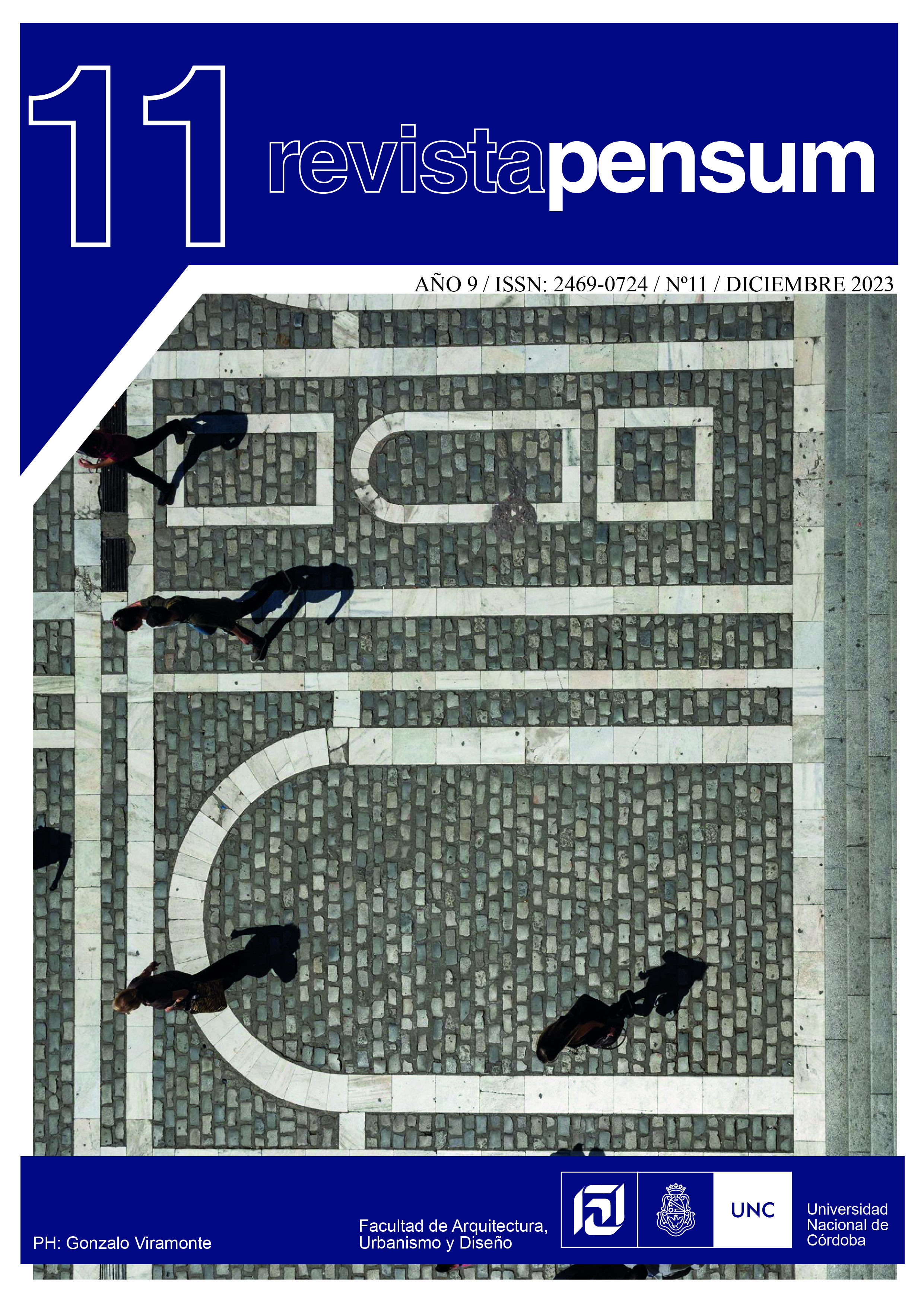Hygrothermal simulation vs. national housing labeling
Critical analysis of methodologies and tools
DOI:
https://doi.org/10.59047/2469.0724.v9.n11.42380Keywords:
Energetic hygrothermal simulation, Housing labeling, Bioclimatic designAbstract
Buildings are responsible for 36% of the global energy demand and more than 30% of the greenhouse gasses principally owing to cooling and heating. This has inspired many countries and institutions to implement certifications of energy efficiency and sustainability like energy efficiency labeling. The present work does a critical analysis of some results obtained besides the advantages and disadvantages of the use of National Housing Labeling (EVN) in relation to the implemented by the Bioclimatic design área (ADB) of Sustainable technologies constructions of the Experimental Center for Affordable Housing. To achieve this an apartment of an own project apartament complex housing made in 2020 for the city council of Rio Cuarto, Córdoba was evaluated with both methodologies. This is located in a zone of Warm temper climate. The similarities, results, the precisión of input and output data, practicality of implementation, feasibility of evaluating other construction systems and upgrade analysis are discussed. One of the principal results shows a 70% of difference in the requirements for cooling and heating with ADB vs EVN, being 63 and 19 KWh/m2/year respectively.
References
Gutiérrez, C. (2010). Ecotect: Software de Diseño de Construcción Sustentable. ArchDaily. Recuperado de https://www.archdaily.cl/cl/02-62481/ecotect-software-de-diseno-de-construccion-sustentable
Gaggino, R., Arguello, R., & Berretta, H. (2010). Procedure for making a cement mixture applicable to the manufacture of building elements. Recent Patents on Materials Science Journal, 3(3), 167-177. ISSN: 1874-4648 (Print) 1874-4656 (Online).
Gaggino, R., Arguello, R., & Berretta, H. (2017). Modelo de gestión para la producción nacional de componentes constructivos para mejoras habitacionales a partir del reciclado de residuos sólidos urbanos. Disciplina: vivienda económica.
Hernández, A. L. (2001). Simulación del Comportamiento Térmico de Edificios – Comparación de Métodos Micro y Macrodinámicos. Tesis Doctoral. Director: Dra. Graciela Lesino. Fac. de Ciencias Exactas, UNSa.
Heywood, H. (2015). 101 reglas básicas para edificios y ciudades sostenibles. Traducción: Susana Landrove. Impreso en Barcelona. ISBN: 978-84-252-2993-0. Editorial GG.
IRAM. (1996). Acondicionamiento térmico de edificios. Condiciones de habitabilidad en edificios. Valores máximos de transmitancia térmica en cerramientos opacos. Norma N° 11605.
LEED (2022). Spain Green Building Council. Recuperado de http://www.spaingbc.org/web/sistemas-clasificacion.php
Municipio de Río Cuarto. (2008). Código de Planeamiento Urbano. Recuperado de https://www.riocuarto.gov.ar/versionanterior/tramites/archivos/1231331316-Codigo2002.pdf
Salvador Gil. (2021). Eficiencia Energética en el Sector Residencial, resumen ejecutivo. Eficiencia Energética. Recuperado de https://eficienciaenergetica.net.ar/novedades_detalle.php?id=80
Stagnitta, R. (2020). Etiquetado de Viviendas Curso de Certificadores [MOOC]. Etiquetado de Viviendas. Recuperado de https://etiquetadoviviendas.mecon.gob.ar/
Secretaría de Ambiente y Desarrollo Sustentable. (2016). Manual de Vivienda Sustentable. C.A.B.A. – República Argentina. Recuperado de https://www.argentina.gob.ar/ambiente/desarrollo-sostenible/vivienda/manual
Sulaiman, H., Mazzocco, M. P., & Filippín, C. (2017). Análisis Económico-Energético de Envolventes Aisladas con Simulación en CASAFAD en dos Ciudades de Argentina. ISSN: 2175-6333 - Anais [do] XIV Encontro Nacional de Conforto no Ambiente Construído e X Encontro Latino–americano de Conforto no Ambiente Construído. Recuperado de http://www.infohab.org.br/encac/files/2017/topico8artigo12.pdf
Sulaiman, H., Oga Martínez, L. M., & Filippín, C. (2020). Diseño con Simulación de Vivienda Colectiva Sustentable en Ciudad Intermedia. Seminario Internacional “Ciudad, Ingeniería y Sostenibilidad (CIS). La Serena, Chile.
Sulaiman, H. C., Sipowicz, E., Filippin, M. C., & Oga Martinez, L. M. (2019). Energy Performance of Dwellings in a Temperate Climate Area of Argentina. An Architectural Proposal. The Open Construction and Building Technology Journal, 14, 1-16. DOI: 10.2174/1874836802014010001.
Poder Ejecutivo Nacional. (2022). Decreto 332/2022: Servicios Públicos de Energía Eléctrica y Gas Natural. Régimen de Segmentación de Subsidios. Boletín Nacional, 16 de junio de 2022. Recuperado de https://www.argentina.gob.ar/normativa/nacional/decreto-332-2022-366629
Repositorio de datos climáticos gratuitos para la simulación del rendimiento de edificios: De los creadores de la EPW. (s. f.). Clima.OneBuilding.Org. Recuperado 15 de agosto de 2022, de https://climate.onebuilding.org/
Taha, H. A. (2012). Investigación de Operaciones (Novena edición). Pearson Educación. ISBN: 978-607-32-0796-6.
Télam. (2018). Para la Cámara de la Construcción, la provincia tiene un déficit de más de 242.000 viviendas. Télam Digital. Recuperado de https://www.telam.com.ar/notas/201803/265383-cordoba-deficit-viviendas-camara-construccion.html
CEVE. (1999-2022). Transferencias tecnológicas al Municipio de Río Cuarto. [1ª 39 viviendas con estructura UMA de CEVE combinada con bloques de Hº producidos por los destinatarios. 2ª 42 viviendas con estructura UMA y placas BENO producidas por destinatarias. 3ª Etapa: año 2004-2005. 5 viviendas con distintas tecnologías de techo producidas por los destinatarios. 4ª Etapa: año 2010-2011. 4 viviendas con estructura UMA y cerramientos de bloques de Hº producidos por los internos de la Penitenciaría Provincial, sede Río Cuarto. 5ª Etapa: año 2014-a la actualidad. Proyecto DETEM (COFECYT): 2 Coop. de trabajo que producen las estructuras UMA, 53 viviendas terminadas. 6ª Etapa: año 2018-a la actualidad. Cumplimentado Primer Taller de Capacitación en producción de componentes en base a PET reciclado (ladrillos, bloques y placas de ladrillos). Desde abril 2019 se puso en marcha una Planta Experimental de Tratamiento de Plástico].
Downloads
Published
Issue
Section
License
Copyright (c) 2023 Halimi Sulaiman, Lautaro Martin Oga Martinez

This work is licensed under a Creative Commons Attribution-ShareAlike 4.0 International License.
Authors who publish in this journal agree to the following terms:
a. Authors retain copyright and guarantee to the journal the right to be the first publication of the work as well as licensed under a Creative Commons Attribution-ShareAlike 4 license.
b. Authors may separately establish additional agreements for non-exclusive distribution of the version of the work published in the journal (e.g., placing it in an institutional repository or publishing it in a book), with an acknowledgement of its initial publication in this journal.
c. Authors are permitted and encouraged to disseminate their work electronically (e.g., in institutional repositories or on their own website) before and during the submission process, as this may result in productive exchanges, as well as earlier and greater citation of published work (See The Effect of Open Access).
d. 4.0 International Creative Commons Attribution-ShareAlike 4.0 License.












